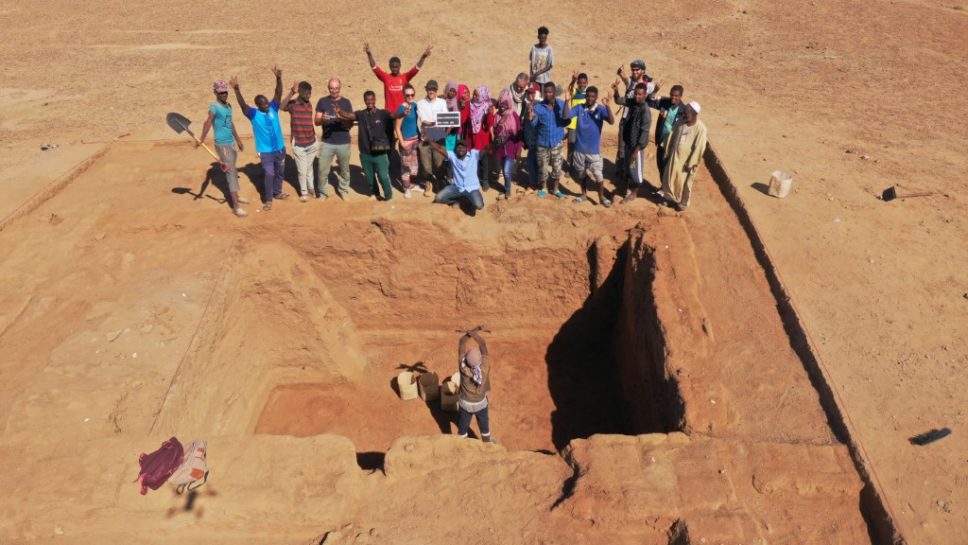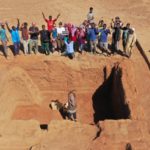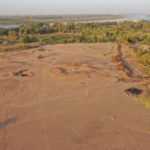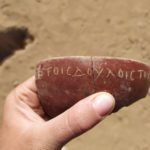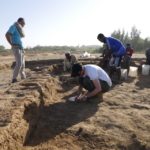The first season of archaeological fieldwork in the medieval city of Soba near Khartoum came to a close mid-February, with very interesting results. A team of researchers from the Polish Centre of Mediterranean Archaeology, University of Warsaw (PCMA UW) and the Institute of Archaeology and Ethnology of the Polish Academy of the Sciences (IAE PAS) documented hitherto unknown districts of the capital city.
Alwa was one of the three kingdoms of Medieval Nubia. According to an Arab traveler’s account, its capital Soba boasted lavish houses, large monasteries, richly-equipped churches and beautiful gardens. It was a multi-ethnic metropolis and the seat of royal and ecclesiastical power. Its former glory is now long-gone and there is not much left on the surface to suggest that it ever existed.
However, geophysical research by a team from the IAE PAS helped to recreate parts of the now-invisible town plan. By mapping magnetic anomalies over an area of 20ha and using a georadar on further 4ha the team found one city district that was densely built-up, with a clear network of streets, and another one where the buildings were less densely spaced, but larger.
It was not possible to map all parts of the site using geophysics, because much of it is covered by modern buildings. However, another method was used by the team to gather information on these areas. Prof. Maciej Kurcz, an ethnologist from the University of Silesia in Katowice, gained access to many ancient objects by talking to the local inhabitants. Apart from documenting artefacts he managed also to gather stories, superstitions and legends regarding the old capital of Alwa.
The team conducted also some traditional archaeological research. – In the course of excavation in different parts of the site we discovered structures made in a number of different building materials – says Dr. Mariusz Drzewiecki of the PCMA UW, the director of the project. Most buildings were erected in mud brick, some of them plastered and painted red. Baked-brick buildings were much worse preserved, because the large medieval bricks have been extensively used as building material in Khartoum since at least two centuries. The medieval city featured also wooden buildings – In our trenches we encountered numerous post holes, some of them still retaining fragments of wooden posts – explains Dr. Drzewiecki.
– Among our finds, the most numerous artefacts were pottery sherds, some richly decorated with painted or incised ornaments. On 38 fragments we found inscriptions in the Greek alphabet. We also documented animal remains, fragments of glass vessels, metal, bone and stone objects. We also collected many organic samples that will be analyzed in the coming months ¬– recounts the archaeologist.
The project leader stresses the fact that the objects discovered during fieldwork will be stored at the site. This decision was made after conducting interviews with local residents, who mentioned that after past visits at the site of people who conducted excavations, the visitors took the uncovered objects away, leaving the locals in the dark as to their meaning or function. That is why the Polish team was intent on getting building permission for a storeroom that would house all their discoveries at the site. The mission has also initiated contact with local schools. – Children are the most numerous group among local residents, and what’s more, they have easy access to people in all other age groups – says Dr. Drzewiecki. That is why the he feels that work with schoolchildren will be the quickest way to communicate the team’s research to the whole community of Soba.
The research project at Soba is financed by grant UMO-2018/29/B/HS3/02533 from the National Science Centre of the Republic of Poland. It is a joint project of the polish Centre of Mediterranean Archaeology, University of Warsaw and the Institute of Archaeology and Ethnology of the Polish Academy of the Sciences. The project cooperates also with the National Corporation for Antiquities and Museums of Sudan, University of Silesia in Katowice, Neelain University (Sudan) and the Historic Environment Scotland.
-
The Soba team, December 2019 / Zespół wykopalisk w Soba, grudzień 2019 (fot. M. Drzewiecki)
-
View of the research area / Widok terenu badań (fot. M. Drzewiecki)
-
Potsherd with Greek inscription / Fragment naczynia ceramicznego z tekstem zapisanym w języku greckim (fot. J. Ciesielska)
-
Excavation work at Soba / Prace wykopaliskowe w Soba (fot. J. Ciesielska)

